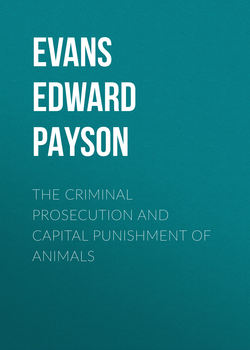The Criminal Prosecution and Capital Punishment of Animals

Реклама. ООО «ЛитРес», ИНН: 7719571260.
Оглавление
Evans Edward Payson. The Criminal Prosecution and Capital Punishment of Animals
INTRODUCTION
CHAPTER I
CHAPTER II
APPENDIX
BIBLIOGRAPHY
Отрывок из книги
It is said that Bartholomew Chassenée,1 a distinguished French jurist of the sixteenth century (born at Issy-l’Evêque in 1480), made his reputation at the bar as counsel for some rats, which had been put on trial before the ecclesiastical court of Autun on the charge of having feloniously eaten up and wantonly destroyed the barley-crop of that province. On complaint formally presented by the magistracy, the official or bishop’s vicar, who exercised jurisdiction in such cases, cited the culprits to appear on a certain day and appointed Chassenée to defend them.
In view of the bad repute and notorious guilt of his clients, Chassenée was forced to employ all sorts of legal shifts and chicane, dilatory pleas and other technical objections, hoping thereby to find some loophole in the meshes of the law through which the accused might escape, or at least to defer and mitigate the sentence of the judge. He urged, in the first place, that inasmuch as the defendants were dispersed over a large tract of country and dwelt in numerous villages, a single summons was insufficient to notify them all; he succeeded, therefore, in obtaining a second citation, to be published from the pulpits of all the parishes inhabited by the said rats. At the expiration of the considerable time which elapsed before this order could be carried into effect and the proclamation be duly made, he excused the default or non-appearance of his clients on the ground of the length and difficulty of the journey and the serious perils which attended it, owing to the unwearied vigilance of their mortal enemies, the cats, who watched all their movements, and, with fell intent, lay in wait for them at every corner and passage. On this point Chassenée addressed the court at some length, in order to show that if a person be cited to appear at a place, to which he cannot come with safety, he may exercise the right of appeal and refuse to obey the writ, even though such appeal be expressly precluded in the summons. The point was argued as seriously as though it were a question of family feud between Capulet and Montague in Verona or Colonna and Orsini in Rome.
.....
It is related in the chronicles of an ancient abbey (Le Père Rochex: Gloire de l’Abbaye et Vallée de la Novalaise), that St. Eldrad commanded the snakes, which infested the environs of a priory in the valley of Briançon, to depart, and, taking a staff in his hand, conducted them to a desert place and shut them up in a cave, where they all miserably perished. Perhaps the serpent, which suffered Satan to take possession of its seductive form and thus played such a fatal part in effecting the fall of man and in introducing sin into the world, may have been regarded as completely out of the pale and protection of law, and as having no rights which an ecclesiastical excommunicator or a wonder-working saint would be bound to respect. As a rule, however, such an arbitrary abuse of miraculous power to the injury or destruction of God’s creatures was considered illegal and unjustifiable, although irascible anchorites and other holy men under strong provocation often gave way to it. Mediæval jurists frowned upon summary measures of this sort, just as modern lawyers condemn the practice of lynch-law as mobbish and essentially seditious, and only to be excused as a sudden outburst of public indignation at some exceptionally brutal outrage.
Properly speaking, animals cannot be excommunicated, but only anathematized; just as women, according to old English law, having no legal status of their own and not being bound in frankpledge as members of the decennary or tithable community, could not be outlawed, but only “waived” or abandoned. This form of ban, while differing theoretically from actual outlawry, was practically the same in its effects upon the individual subjected to it. Excommunication is, as the etymology of the word implies, the exclusion from the communion of the Church and from whatever spiritual or temporal advantages may accrue to a person from this relation. It is one of the consequences of an anathema, but is limited in its operation to members of the ecclesiastical body, to which the lower animals do not belong. This was the generally accepted view, and is the opinion maintained by Gaspard Bailly, advocate and councillor of the Sovereign Senate of Savoy, in his Traité des Monitoires, avec un Plaidoyer contre les Insects, printed at Lyons in 1668, but it has not always been held by writers on this subject, some of whom do not recognize this distinction between anathema and excommunication on the authority of many passages of Holy Writ, affirming that, as the whole creation was corrupted by the fall, so the atonement extends to all living creatures, which are represented as longing for the day of their redemption and regeneration.
.....